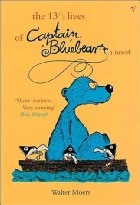Review: ‘The 13 1/2 Lives of Captain Bluebear’ by Walter Moers
Title: The 13 1/2 Lives of Captain Bluebear – Being the biography of a seagoing bear, with numerous illustrations and excerpts from the ‘Encyclopaedia of the Marvels, Life Forms and Other Phenomena of Zamonia and its Environs’ by Professor Abdullah Nightingale
Author: Walter Moers, trans. John Brownjohn
Published: Vintage, 2001, pp. 704
Genre: Fantasy
Blurb: Some Minipirates find a baby bear with blue fur inside a walnut shell floating on the ocean toward a giant whirlpool. They rescue him and teach him about knots and waves, and that a good white lie is often considerably more exciting than the truth. Then, when he outgrows their ship to such an extent that he is in danger of sinking it, they abandon him on an island with a bottle of seaweed juice and a loaf of seaweed bread. Thus Bluebear comes to the end of his first life and embarks on his second. By the end of the book, he has expended exactly half of his 27 lives. Again and again, Moers confounds our expectations as the narrative twists and turns, travels backwards and forwards in time… Part science fiction, part fairy tale, part myth, part epic, this book is a satire on all these genres and so constantly satirises itself.
When, where and why: I must have bought this book a long time ago as I remember buying it from Waterstones, and I’ve not bought a full priced book for years. I picked it up then because it looked bizarre and entertaining. Now, because I do most of my reading while travelling to and from work, I mentally divide my books into ‘books small enough to read on the train’ and ‘books which will result in wrist injury and/or braining of other passengers if attempted to read on the train’. This is a big book and so has been my at home read for the past month or so. It’s also book 17/50 for my Books Off the Shelf Challenge.
What I thought: If you can imagine The Odyssey crossed with Doctor Who then you’ll have a pretty good idea of what this book is like. The story of Bluebear and his various lives travelling around the bizarre continent of Zamonia read like a strange hybrid of epic Greek literature with its twists and turns, deus ex machina and meandering journeys, and a series of Doctor Who episodes with their wacky logic, improbable but enjoyable situations and strange cast of characters. It was unusual, unexpected and I loved it.
What makes the world of Zamonia so interesting and this book so absorbing is the huge amount of detail that Walter Moers has put into it. All of the characters and locations are well fleshed out and immersive to read about. This is largely due to the constant interjections into the text from the encyclopedia mentioned in the book’s extended title. During his sixth life, Bluebear has an encyclopedia put inside his head by Professor Nightingale,and throughout the rest of the narrative this encyclopedia pops up like an individual character to offer helpful information about the strange createures, places and phenomena that Bluebear encounters. Walter Moers has put so much care into developing this world that he could have written at least five books with all the material he provides. Instead, it’s all stuffed into one complex book, bursting at the seams with delightful oddments of information.
Unfortunately, this book’s greatest strength was also its greatest weakness. There were so many details and so many tangents that the story sometimes got lost and it meandered a bit too much. Unlike Odysseus and the Doctor, Bluebear’s adventure has no ultimate aim: Odysseus is trying to get home, the Doctor is trying to save the world, but Bluebear is just journeying across Zamonia. His travels are fascinating, but a designated end point might have helped to move along a narrative which occasionally became sluggish and to avoid the occasional feeling that it was devolving into a series of lists (albeit very entertaining lists) and random, unconnected incidents.
Nonetheless, this book is a joy to read, not only because of the story but because of the book itself. The text is accompanied throughout by pictures which are funny, well-drawn and (probably because the author himself illustrates the book) perfectly capture the visions I had in my head while reading. The type is also formatted differently to reflect different characters talking, different languages and different actions, so that this is a book that you experience rather than read. And a very good experience it is too.
Where this book is going: This book is definitely staying with me, but I suspect it will do the rounds of a great many friends and family members first. It’s too enjoyable not to share.

